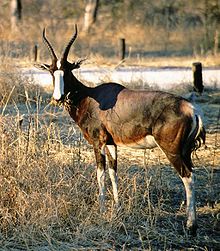- Bontebok
-
This article is about the antelope. For the Dutch village, see Bontebok, Heerenveen.
Bontebok 
Bontebok in Etosha National Park, Namibia Conservation status Scientific classification Kingdom: Animalia Phylum: Chordata Class: Mammalia Order: Artiodactyla Family: Bovidae Subfamily: Alcelaphinae Genus: Damaliscus Species: D. pygargus Binomial name Damaliscus pygargus
(Pallas, 1767)Subspecies - Damaliscus pygargus pygarus
- Damaliscus pygargus phillipsi
The Bontebok is an antelope found in South Africa and Lesotho. The Bontebok has two subspecies; the endangered Bontebok (Damaliscus pygargus pygarus),[2] occurring naturally in the Fynbos and Renosterveld areas of the Western Cape, and the Blesbok (Damaliscus pygargus phillipsi) occurring in the highveld.
The Bontebok stands 80 to 100 cm at the shoulder and weighs 50 to 90 kg. The Bontebok is a chocolate brown colour, with a white underside and a white stripe from the forehead to the tip of the nose, although there is a brown stripe across the white near the eyes in most Blesbok. Bontebok also has a distinctive white patch around its tail (whence the Latin name), while this patch is light brown/tan in Blesbok. The horns of Bontebok are lyre-shaped and clearly ringed they are found in both sexes and can reach a length of half a metre.
Blesbok live in highveld where they eat short grasses, while Bontebok are restricted to coastal Fynbos and Renosterveld (Skead, 1980). They are diurnal, though they rest during the heat of the day. Herds contain only males, only females or are mixed and do not exceed forty animals for Bonteboks or seventy for Blesboks.
Bontebok are not good jumpers but they are very good at crawling under things. Mature males form territories and face down other males in displays and occasionally combat.
Bontebok were once extensively killed as pests, and were reduced to a wild population of just seventeen animals, but the species has since recovered. Blesbok are extinct in their natural habitat but they have increased in population to the point where they are now very abundant and avidly farmed, because they are popular quarry for hunters and are easy to sustain.
References
- ^ Lloyd, P. & David, J. (2008). Damaliscus pygargus. In: IUCN 2008. IUCN Red List of Threatened Species. Downloaded on 5 April 2009. Database entry includes a brief justification of why this species is of least concern.
- ^ Wilson, Don E.; Reeder, DeeAnn M., eds (2005). Mammal Species of the World (3rd ed.). Baltimore: Johns Hopkins University Press, 2 vols. (2142 pp.). ISBN 978-0-8018-8221-0. OCLC 62265494. http://www.bucknell.edu/msw3/browse.asp?id=14200523.
- SKEAD, C.J. 1980. Historical mammal incidence in the Cape Province Volume 1. The Department of Nature and Environmental Conservation of the Provincial Administration of the Cape of Good Hope, Cape Town.
Categories:- IUCN Red List least concern species
- Alcelaphinae
- Mammals of Africa
- Megafauna of Africa
Wikimedia Foundation. 2010.






